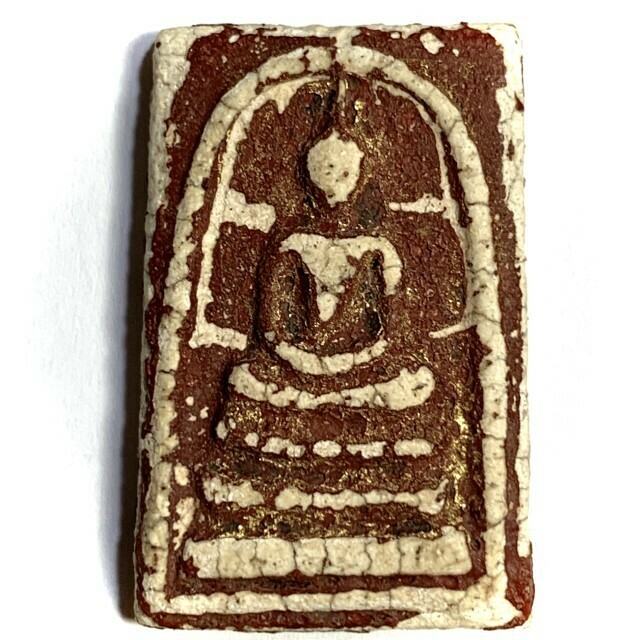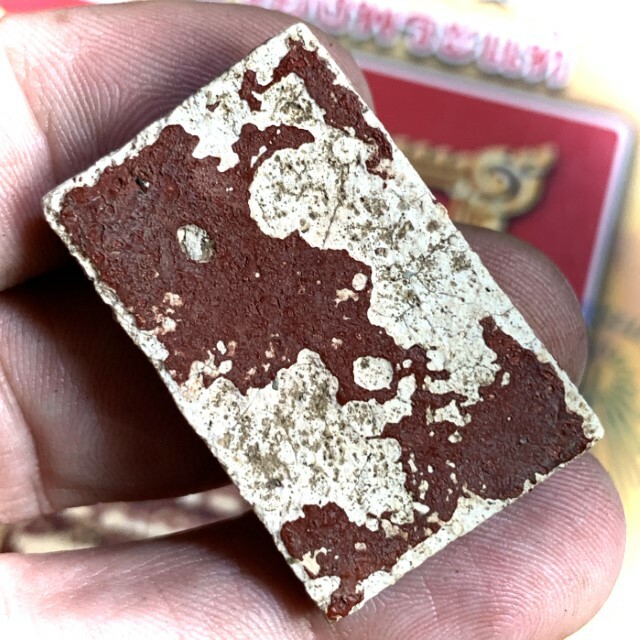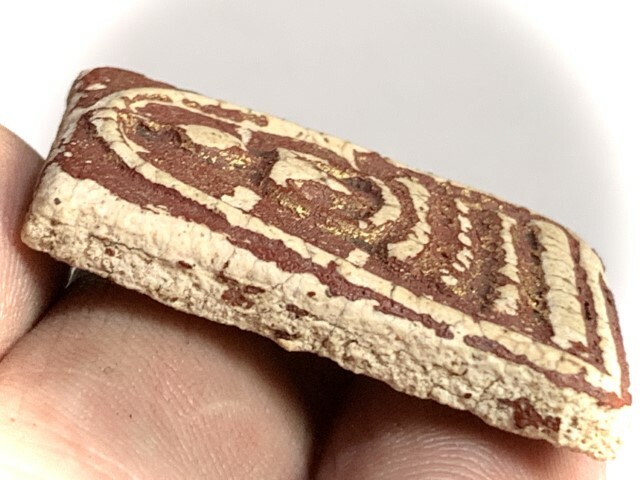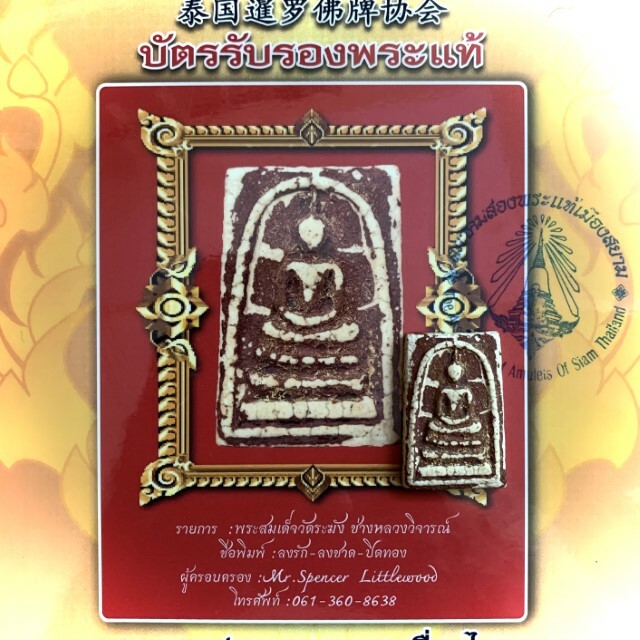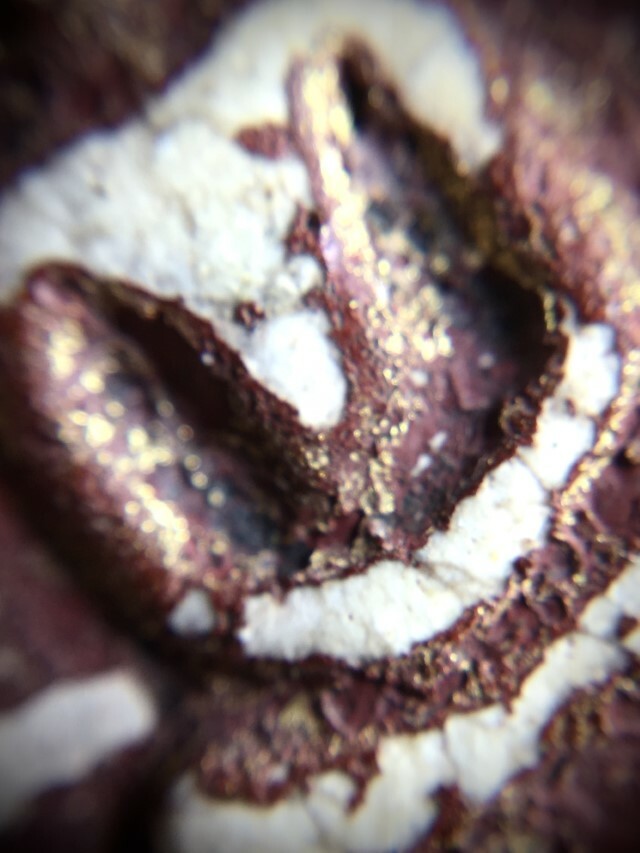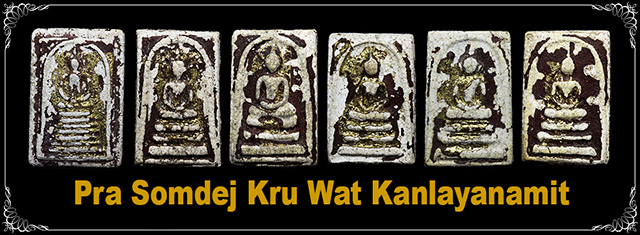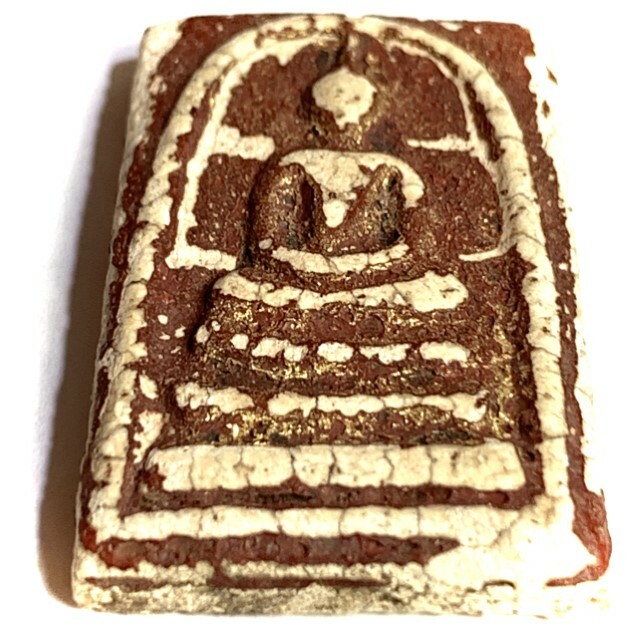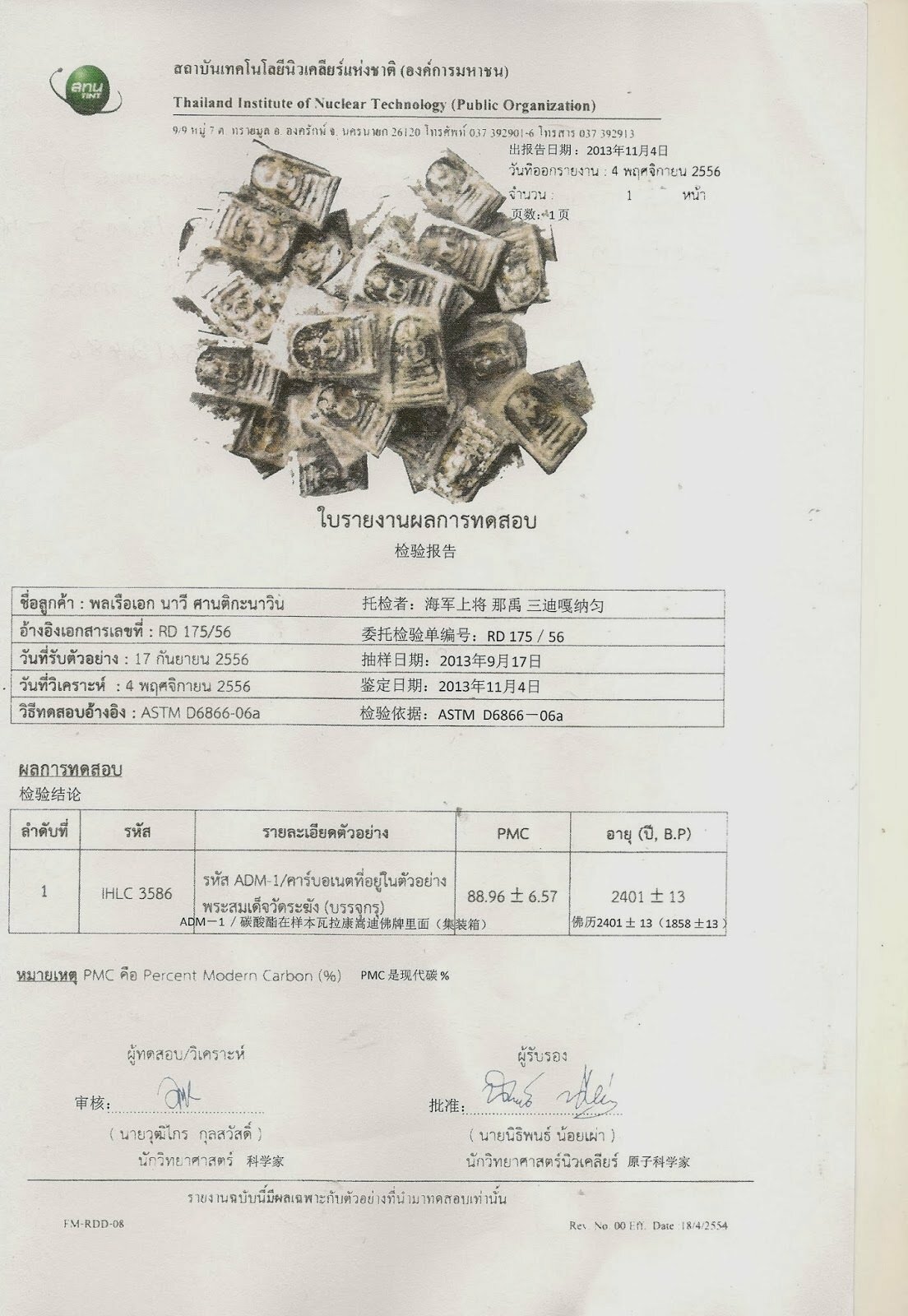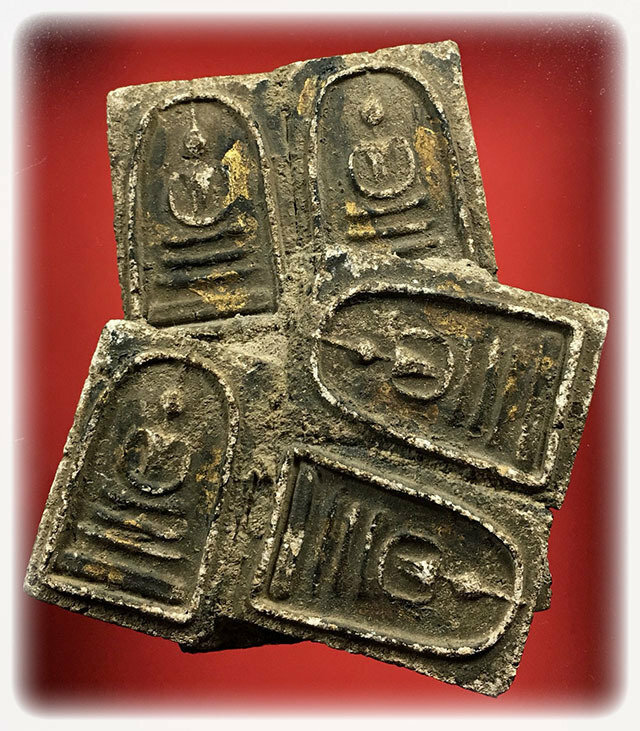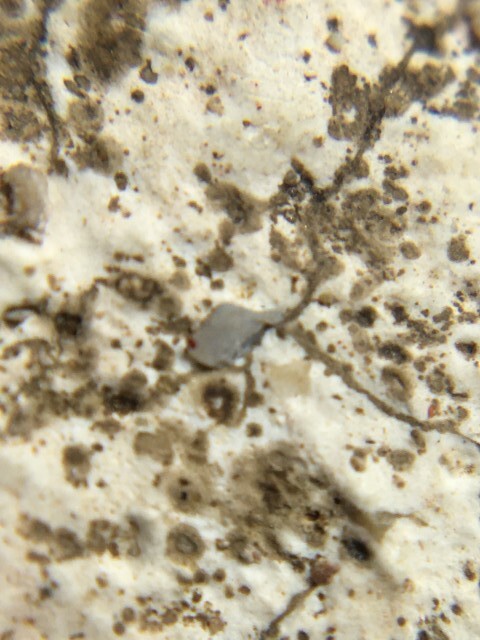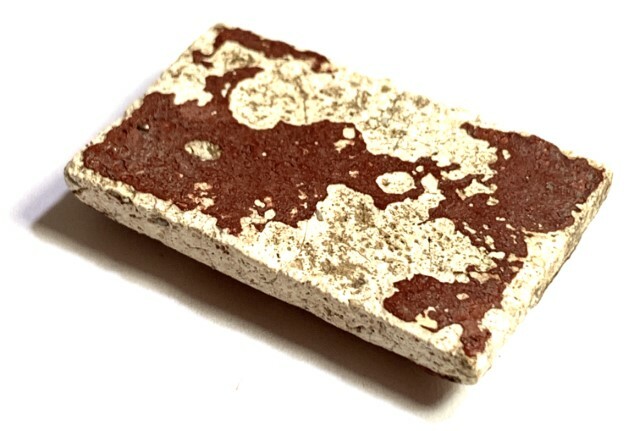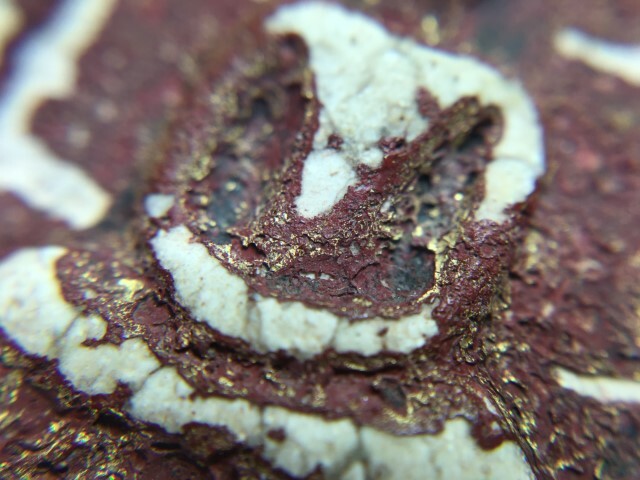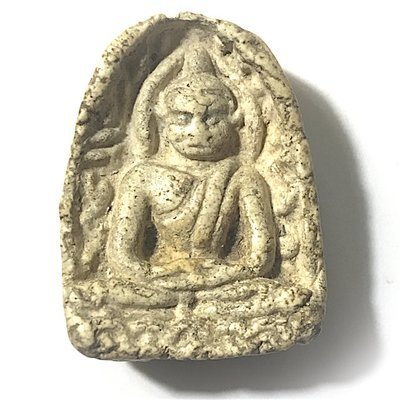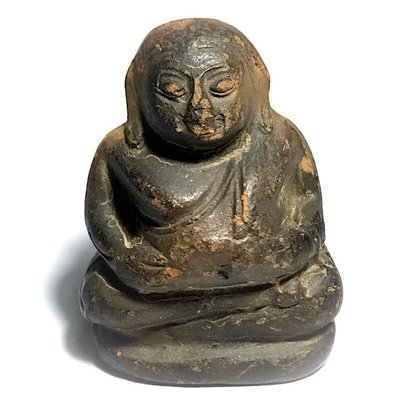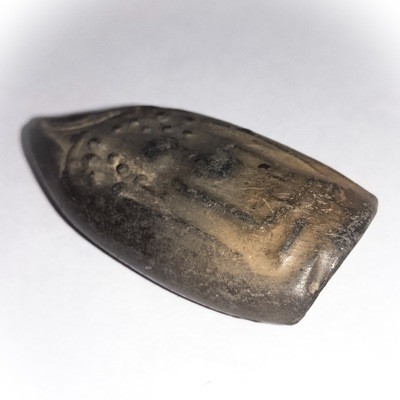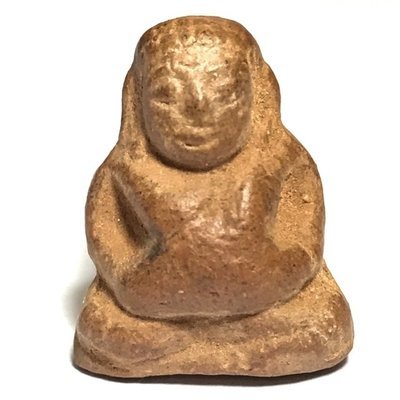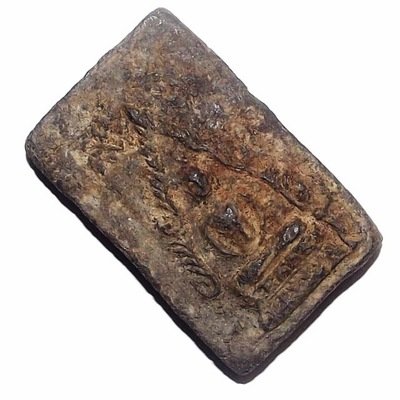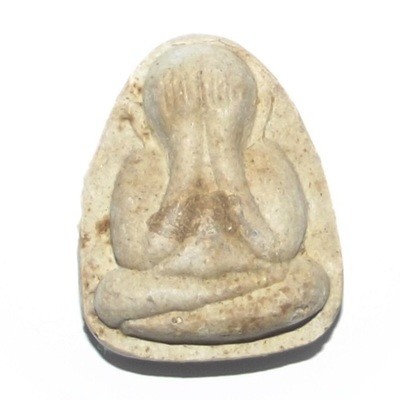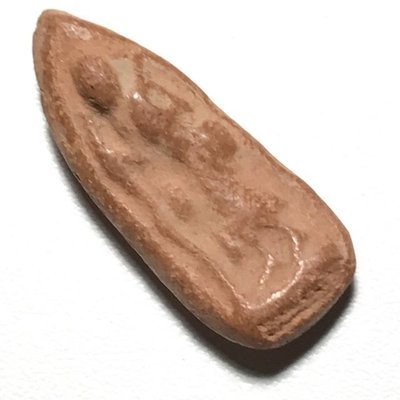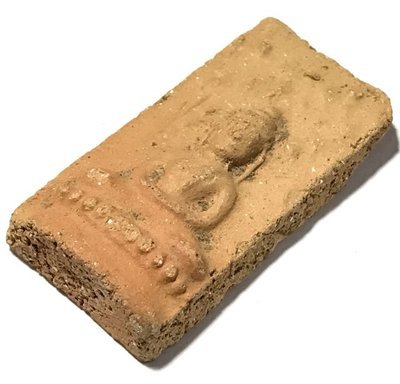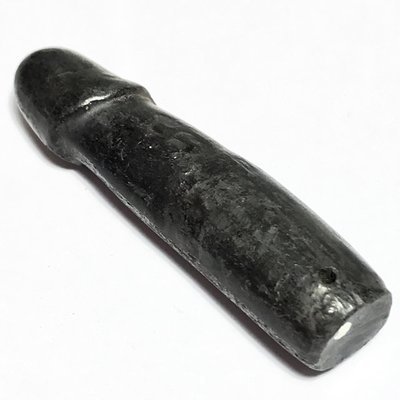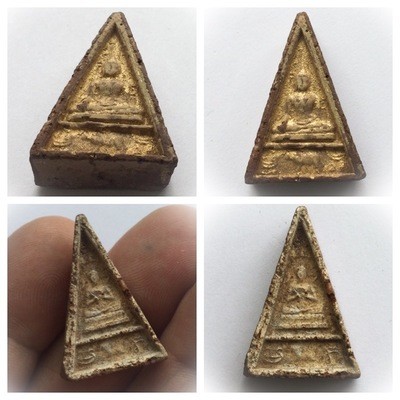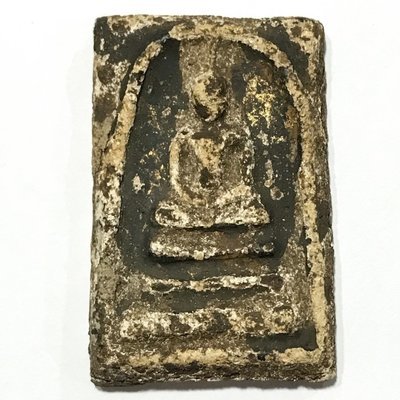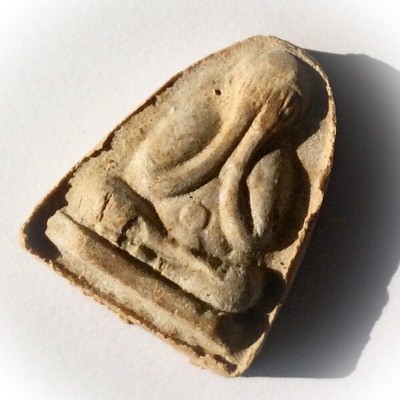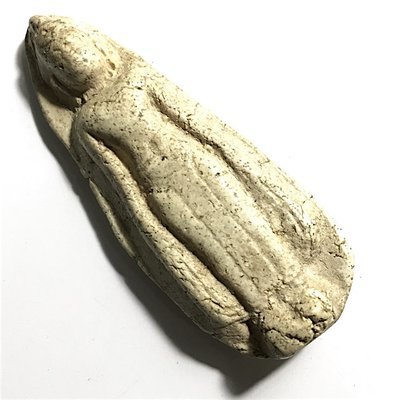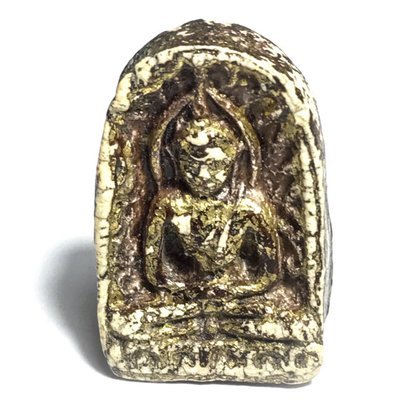A pristinely kept and extremely rare Rian Mangorn Koo Nuea Nava Loha Pim Pised Dtok Sorng Code Ma Wat Pha Nong Lom Run Sao Ha Maha Sethee 5th Lunar Saturday Blessing Ceremony Edition Guru Monk Coin, released in 2543 BE, to raise funds for the Kuti Songk Monks Huts and improve the facilities at the temple of Wat Pha Nong Lom.
This model of Rian Mangorn Koo twin dragons Monk Coin is a very rare Pim Pised (Niyom preferred) and differs from the majority of Rian Mangorn Koo Wat Pha Nong Lom Edition coins in Nava Loha, because of the double code MA stamp. Most coins of the Nava Loha series made for Wat Pha Nong Lom have only a single code Ma Stamp (on the Sangkati chest sash of the robe of Luang Phu), and only the Pim Pised special models received double code stamps. Only very few (unknown number) were distributed with double code stamp, making this not only a sacred, powerful master class amulet, but also a rare collectors piece.
The Rian Mangorn Koo of Luang Phu Hmun is, as are all of his amulets, known for the power of Jaroen Lap Wealth Increasement, and Lucky Fortunes, as well as for their Miraculous Protective Powers. Those born in the year of the dragon love to Bucha this amulet especially, for the obvious reason of the double dragon guardians.
For those with lower budgets, who seek power above collectability and rarity, we recommend to seek the Rian Mangorn Nuea Tong Daeng or Nava Loha single Code Ma, of the same edition, which carries a lower price than this special Nava Loha Pim Pised Gammagarn double code collectors edition model.
Pra Somdej Wat Rakang Long Rak Chart Pid Tong Kru Wat Kanlayanamit Red Lacquer Gold Leaf with Certificate Free FedEx
A now very well known and sought after Master Class ancient amulet of the Benjapakee Immortal Classic Family, the Pra Somdej Wat Rakang Kru Wat Kanlayanamit, this Pim Being a Pim Chang Luang Wijarn, with Rak Chart (ancient red lacquer) Pid Tong (gold leaf), of the great Somdej Pra Puttajarn (Dto) Prohmrangsri of Wat Rakang Kositaram, this model is an extremely attractive Pim Niyom model of the 'Chang Sip Moo' Artisan Chang Luang Wijarn. Oficially classified as Pra Somdej Wat Rakang Kositaram, our Proprietor Ajarn Spencer Littlewood has further defiined this model to be a cleaned exhibit from the Kru Wat Kanlayanamit burial chamber
Free Express EMS / Fed-Ex, or DHL Air Shipping is included with this amulet (depending on what is available to us at time of purchase). A truly ancient amulet, with a beauty from the gold leaf and lacquer that has created its own niche following of the Kru Wat Kanlayanamit collectors, who show preference the red lacquer and/or gold leaf to the plain style models. The Pra Somdej is one of the 'Benja Pakee' official set of five national amulets of Thailand seen as the most sacred, desirable and representative of every region of Thailand. In recent decades various Kru hiding place finds have been discovered in temples where Somdej Dto built statues and traveled, such as the Kru Wat Kanlayanamit, and Kru Wat Sadter finds.
The rear face of this exhibit is inimitable and has immensely beautiful markings, of a classic Pra Somdej Wat Rakang. Various exhibits display different textrures on the rear faces, for they were laid on various surfaces to sun dry, ranging from marble stone to mai gradan wooden boards. In truth, no two Pra Somdej Wat Rakang are the same, and each amulet has its own individual character, which is of course one of the many aspects which form part of what makes the Pra Somdej Wat Rakang the title holder of 'The King of Thai Amulets'.
The amulet comes with the A4 size certificate of authenticity as a Pra Somdej Wat Rakang Long Rak Pid Tong of Somdej Pra Puttajarn (Dto) Prohmrangsri, with definition of the preferred artisan as authentic issued from the Pra Tae Mueang Siam Amulet Association. The certificate does not state that the model is from Kru Wat Kanlayanamit, rather defines it simply as 'Wat Rakang Kositaram' because the Wat Kanlayanamit find were actually Pra Somdej Wat Rakang, taken to and placed in the Kru Hiding Place, and also because Ajarn Spencer is highly focused on accuracy, even more so than many societies, & his studies have led him to define this exhibit further, as coming from the Wat Kanlayanamit find.
An Immortal Classic and one of the most famous Thai Buddhist Amulets of all time, as well as being amongst the top preferred amulets of the serious devotee and wealthy collector of the accepted amulets of Somdej Pra Puttajarn (Dto) Prohmrangsri, of Wat Rakang Kositaram, whose Pra Somdej are the number one amulets of all time, be they from Wat Rakang, Wat Bang Khun Prohm, or Wat Gaes Chaiyo. Be they straight from Wat Rakang, or found in smaller Kru such as the Kru Tap Khaw, or the Kru Wat Kanlayanamit, all Pra Somdej Wat Rakang of Somdej Dto have the same spiritual value, if not the same monetary price,
Made almost 1.5 -2 centuries ago, the Pra Somdej Wat Rakang can be considered the number one amulet of all time in Thailand for its historical fame and legendary status, and the immense Grandeur of its maker. The Pra Somdej Wat Kanlayanamit is considered to be among the most affordable of all and are hence extremely popular since their discovery
The standard Pra Somdej Amulets of Somdej Dto, are officially recognized as coming from one (or all) of four Royal temples; Wat Intrra Wiharn (Bang Khun Prohm Nai), Wat Gaes Chaiyo, Wat Hmai Bang Khun Prom, and of course last but not least, Wat Rakang Kositaram. Most of these amulets are given a Puttapisek blessing ceremony in the temple where they were made, but then travel to at least two or three of the other temples to be laid under the 'Pra Pratan' (main Buddha statue in the shrine), and absorb the prayers of the Sangha (Monks), for further sacredness and power. However, as Somdej Dto created many large Buddha statues for other temples, his amulets have been found hidden within various, including the Wat Kanlayanamit, Wat Sadter and Kru Tap Khaw hiding place finds.
This amulet comes with its certificate of authenticity in form of a A4 sized plastified certificate photo of the Chomrom Pra Tae Mueang Siam Amulet Appreciation society and complimentary box with authenticity confirmation sticker. We offer free Solid Gold, Solid Silver, Stainless Steel, or Waterproof Casing with this amulet, whichever you prefer. Free EMS/DHL Shipping is also included in the price
The rear face shows the presence of all the classic features and muan sarn ingredients of a true Pra Somdej Wat Rakang of Somdej Dto, with a beautiful lined pattern resulting from shrinkage and drying over almost two centuries of ageing, and which has added to the character and increases the ease of authentication. This kind of rear face pattern is highly preferred amongst aficionados and serious devotee-collectors, for its classic aged appearance.
The contents of the Muan Sarn Sacred Clay reveal the necessary aspects and content expected from an authentic Pra Somdej Wat Rakang. The design of the front face is exquisite, as were all the block presses carved for Somdej Dto by the artisan Luang Wijarn, one of the royal artisans of the Chang Sip Moo group of artisans.
Pra Somdej Wat Rakang is one of the classic Pra Somdej amulets of Somdej Dto available, along with Pra Somdej Wat Gaes Chaiyo, and the Pra Somdej Wat Bang Khun Prohm amulet as far as popularity, beauty, sacredness of Puttapisek ceremony and price range.
Once unheard of, and for some years disputed, the Pra Somdej Wat Rakang Wat Kanlayanamit has become one of the two most sought after amulets of Somdej Dto in the current Era. The Somdej Wat Rakang Kru Wat Kanlayanamit was a most welcome discovery, after many decades where it was impossible to find an authentic Somdej Wat Rakang, due to the till then accepted models being limited to 9 or 10 Pim (designs) which were not placed in any Kru, and released directly at Wat Rakang.
Up until around the end of the 20th Century, the Pra Somdej released directly at Wat Rakang were the only ones accepted by undisputed monopolistic societies in those days. In truth, when we consider the documented edition which is historically recorded, was made towards the end of Somdej Dto's life, and in truth, Somdej Dto was making and distributing (and hiding) amulets during his whole lifetime, and was distributing throughout his 25 years of disappearance on Tudong traveling the Land.
Since then these closed minded monopolists have had their bubble burst, as the era of Internet allowed more ease of communication between people, and knowledge became easier to spread, and various amulet finds in temples where Somdej Dto stayed have come to light.
Hence, the appearance of the Muan Sarn clay is 'Nuea Jad Haeng', dry and coarse surface effect. The amulets were treated with lacquer and gold leaf on most versions, which becomes more visible in models which devotees have cleaned off the Kraap Kru residue, which builds up on the surface of hiding place amulets over decades and centuries. The Pra Somdej Wat Rakang Kru Wat Kanlayanamit is along with the Pra Somdej Wat Rakang Kru Wat Sadter, equally favoured and fervently collected by devotees of Somdej Dto Prohmrangsri, and both hiding place finds.
The 'Nuea Ha' visual content of the Muan Sarn Clay differs from that found in the Pra Somdej Wat Rakang Kru Wat Bang Khun Prohm, and the Pra Somdej Wat Rakang of Wat Sadter, in the sense that both of those Kru chambers were 'Kru Piak' (endured floods), and the Kru Wat Kanlayanamit find amulets came from a 'Kru Haeng' (dry chamber).
The Kru Wat Kanlayanamit amulets were given Nuclear testing for determination of their true age by navy commander Navee Santikanawin, by means of both carbon dating and also through chemical testing, which cost the destruction of three amulets to make enough substance for testing. The results came out that the amulets were determined to have been made somewhere around 2388 and 2413 BE (2401 BE Plus or minus 13 years), confirming the right age for them to have been made by Somdej Pra Puttajarn Dto Prohmrangsri. The tests were made at the National Institute of Nuclear Technology. However, our Proprietor Ajarn Spencer says that Nuclear testing is not the standard acceptable way to recognize the amulets of Somdej Dto in his opinion, and that only the true expertise of perusal under the naked eye with various magnifications, and close intuitive examination, is valid as the final conclusive factor of authentication. Ajarn Spencer does not lay his belief in certificates or scientific testing methods, rather, believes in the fact that only an experienced aficionado and student with many years of experience viewing and studying his chosen field of amulets can conclude authenticity. Ajarn Spencer insists on checking each amulet himself taking time to peruse in detail, regardless of whether the amulet already has a certificate or not.
The fact that the Pim, which were found, are also recognizable as being from Chang Luang Wijarn of the Chang Sip Moo artisans who made the block presses of the Pra Somdej Wat Rakang. The Pra Somdej Kru Wat Kanlayanamit hiding place amulets were found inside the Chedi Stupa at the temple in the year 2551 BE, with a large number of amulets of various Pim Song designs, mostly being Pra Somdej Pim Yai, Pim Sen Daay, Pim Thaan Koo, Pim Chedi, Pim Prok Po, Pim Ok Krut, and Pim Thaan Saem. There were also some smaller numbers of other amulets found, such as Pra Sangkajjai, and Pra Sayasana (reclining Buddha), as well as some votive tablets composed of nine Pra Somdej stuck together in a clump, and also some Somdej Koo twin Pra Somdej stuck together 'Siamese Twin' style. Various other unusual models were found but only in very small numbers.
At first after the find, the amulets were heavily criticised by the 'Sian Pra' , who were in those days still limited to a group of afilliated monopolist Bankokian amulet scene speculators and auctioneers, who used their self published works to establish a highly limited pantheon of 'accepted', which were limited to 8 0r 10 specific models of Pra Somdej amulets. The Pra Somdej Kru Wat Kanlayanamit amulet, is now an accepted competition class amulet which can be entered for competition and/or certification with many associations, and any true student of the amulets of Somdej Dto, whose eyes are trained, can confirm for himself the authenticity of the Muan Sarn and the Pim, with great ease.
One could say that the Pra Somdej Wat Rakang of Wat Kanlayanamit and indeed Wat Sadter, could be called 'Prodigal Sons' for indeed, they are like long lost loved ones who have returned from a long time away from sight. It is a joy for the devotee of Somdej Dto to encounter a replenished supply of available authentic Pra Somdej Wat rakang of Somdej Dto available for Bucha, at proces which are far below the price of those Pra Somdej Wat Rakang, Wat Gaes Chaiyo, and Somdej Kru Bang Khun Prohm, which have dominated the scene for the last 10 decades. We highly recommend both the Pra Somdej Wat Rakang Kru Wat Kanlayanamit and the Kru Wat Sadter amulets, for we believe that their affordability will not last for many years, and that they too will eventually become as unaffordable as their long time accepted peers from Wat Rakang and Wat Bang Khun Prohm and Wat Gaes Chaiyo.
In simple terms, a Pra Somdej Wat Kanlayanamit, or a Pra Somdej Wat Sadter, is one and the same amulet as the Pra Somdej Wat Rakang, and from the same Maker, namely Somdej pra Puttajarn Dto Prohmrangsri. The way of defining which Kru hiding place the amulet comes from, is a matter of examination and Muan Sarn. For this reason, one can expect both of these Pra Kru Somdej editions to eventually deplete and become priceless classics of millionaire status within a period of perhaps a decade since their find, which is already now beginning to become noticeable that the occasions on which one sees a Somdej Wat Kanlayanamit is becoming ever rarer.
Points of Comparison
The Pra Somdej Wat Kanlayanamit amulet find batch were hidden in a chamber of the Chedi Stupa at Wat Kanlayanamit, which never experienced flooding, and allowed the amulets to remain very dry, resulting in a much more granular texture to the surface of the clay, and for the lacquer and gold leaf beneath the residues to remain intact, whereas the Pra Somdej Amulets of the Kru Wat Sadter Hiding Place Find, were hidden in the Kru immersed below the water level for a very long time, which caused the original 'Rak' lacquer which covered many of them to wear out and detach from the surface of the amulets.
This resulted in both the Kru Wat Kanlayanamit and also the Kru Wat Sadter Sacred Pra Somdej amulets, each possessing their own inimitable appearance, which differs from the Pra Somdej Wat Rakang Kositaram, due to the long time period spent under different atmospheric conditions, with high moisture and humidity. The result in both batches is a very eye catching and Sacred appearance which has only served to increase the depth of study content when examining the various features and aspects of the Muan Sarn Sacred Powders (ageing, contraction, ingredients, hardness, density, surface texture)..
The rear faces are found with varied appearance, depending on whether they were laid on a Mai Gradan (blackboard) which leaves ridged lines on the back face, or if they were laid on stone or other surfaces to dry after they were pressed, which leaves a smoother surface, or even a porous holed surface. Precisely these patterns are evident on the Pra Somdej at Wat Rakang Kositaram, and are found to be identical to those in the Pra Somdej Kru Wat Kanlayanamit and the Kru Wat Sadter amulet find.
The Pra Somdej Wat Rakang Kositaram of Somdej Pra Puttajarn (Dto) Prohmrangsri which were kept at, and released through Wat Rakang, were never placed in Kru Burial, and hence maintained a clean surface appearance. But the Pra Somdej which Somdej Pra Puttajarn (Dto) Prohmrangsri took and buried in hiding chambers in temples around the country, were subjected to climatic changes, flooding, droughts and heatwaves. This is the reason for the fact that the red, or black lacquers found on the surface of the amulets found at Wat Kanlayanamit are intact, in most examples, with broken lacquer on some exhibits which have been cleaned by devotees, or which were later exposed to water during a later time.
But the Somdej Kru Wat Sadter, in most cases have less lacquer than the Wat Kanlayanamit find batch, that is flaked off from exposure to water. The remaining bits of lacquer which can be found visible in lesser or greater amounts on the amulets is extremely dry and hermetically attached to the surface of the amulets, from over a Century and a Half in burial.
In the Wongarn Pra Niyom Amulet Aficionado circles, this is called 'Nuea Rak Dtaay' meaning 'the lacquer has passed away'. This is used to refer to the effect of the laquer breaking off leaving stains in a crackled pattern, that lends an effect to the surface of the amulets, and only serves to enrichen its character and eye- pleasing effect. Some exhibits remain with highly evident lacquer traces, whereas others have been cleaned at some point (some devotees would clean the amulets, others would leave them in their natural state, according to personal preference).
For the Group who revere the Pra Somdej Kru Wat Kanlayanamit amulet as that of Somdej Pra Puttajarn (Dto) Prohmrangsri Wat Rakang Kositaram, we are beholding an Eternal Classic, and one of the most Sacred Amulets, which has blessed us by escaping the clutches of the speculative investors. It is considered a top hit, because despite its age, fame and sacred power, is still affordable, and within the reach of most people. A Highly recommended amulet for those who seriously seek the honour of wearing and revering what well studied aficionados accept to be a true Pra Somdej Wat Rakang Kositaram, of the Great Somdej Pra Puttajarn (Dto) Prohmrangsri.
The Pra Somdej Wat Rakang amulet is the Keystone and Master amulet (Ongk Kroo) for all other Pra Somdej amulets. It is an image in the likeness of the Buddha sitting on a Dais, which was essentially created by Somdej Pra Puttajarn (Dto) Prohmrangsri, of Wat Rakang Kositaram. There are various different ‘Pim’ (models) with varying design features.
The Pra Somdej Wat Rakang, are considered to have extremely powerful Buddha magic in them due to the richness of sacred powders and powerful blessings contained within from great master Somdej Dto. Its general appearance is that of an oblong about 2.4 cm wide up to 4 cm high (varies between these sizes), made from white sacred powders mixed together. The Pra Somdej Wat Rakang Kositaram Pim Gaes Talu Sum is Similar to the Pra Somdej Pim Pra Pratan, but has the ‘Pra Gaes’ Topknot piercing the arch at the top of the amulet. The Pim Jarod Sum touches the arch or approaches it, but does not pierce.
The main Ingredients of the amulets (Muan Sarn Samkan) were made from a base of sea shells, dried rice left from alms round, the five sacred magic powders of Somdej Dto, and ‘Nam Man Dtang Iw’ (special oil for mixing). Nam Man Dtang Iw, or Tung Oil in English, is a preferred oil for mixing and curing amulets with, for it is superior to any other oil as far as water resistance is concerned (one reason why Pra Somdej amulets can be soaked in water without going soft). The oil is much more resistant to mold than its derivatives, such as linseed oil.
The Dtamra must be made by creating exactly 84,000 amulets, equal to the number of Suttas of the Tripitaka. There are different Pim Song (shapes and sizes) of Pra Somdej Wat Rakang, but those which are officially recognized and listed by the ‘wongarn Pra Krueang’ as far as Somdej Wat Rakang amulets are concerned, basically consist of the following officially recognised Pim of Pra Somdej amulets; Pim Pra Pratan, Pim Yai Niyom, Pim Chedi, Pim Prok Po, Pim Gaes Bua Dtum, Pim Gaes Talu Sum, and Pim Thaan Saem.
Somdej Wat Rakang amulets have various surface textures, categorized as 'Nuea Laiad' (fine texture cement mixture), 'Nuea Hyaab'' (rough textured cement mixture), 'Nuea Gae Nam Man Dtang Iw' (old looking textured cement mixture), otherwise known as 'Nuea Sangkhayaa', and 'Nuea Gae Bpoon' (old cement mixture).The basic structure of the design of the classic Somdej, (and almost all Somdej amulets from other temples too), is that of the Lord Buddha sitting inside a Bell (the word 'Rakang' means 'Bell' – 'Wat Rakang' means 'Temple of the Bell').
This is the primary importance of the Somdej amulet in the sense that Somdej from most temples depict the Buddha sitting within a bell which is represented by the arch. The arched structure in amulets is called a 'Sum'. Although these rules do not necessarily always apply (there are a lot of Somdej which are in circulation which are most certainly authentic, but which are not preferred in the collector scene)
There are many less preferred editions which do not fulfill these standard rules of recognition, which is of course one of the reasons why some Somdej Wat Rakang amulets are able to sell for high prices and enter competition, get certificated etc, and why some are not, despite their most probable authenticity.
The difference in the various mixtures made for each 'Pim' have led to differing textures and appearances in the Pra Somdej collections, which provides for a varied and fascinating niche interest, which one can verily spend a whole lifetime studying and accumulating experience and knowledge about this, the King of all amulets.





